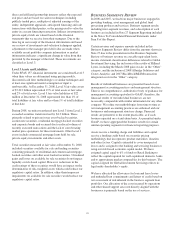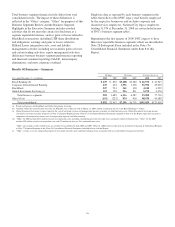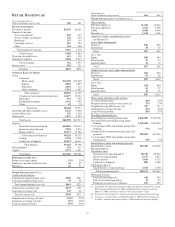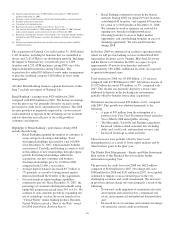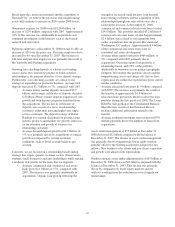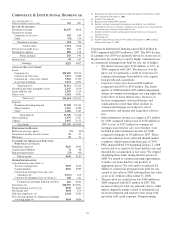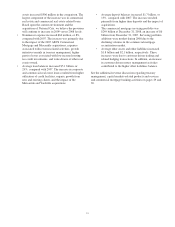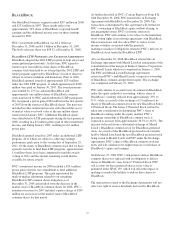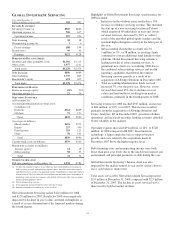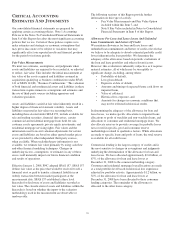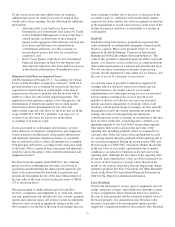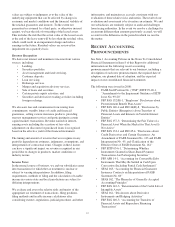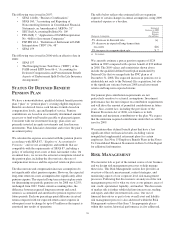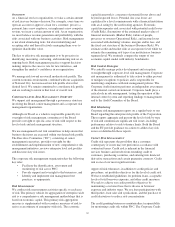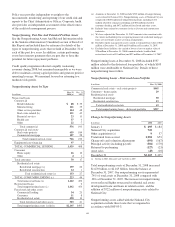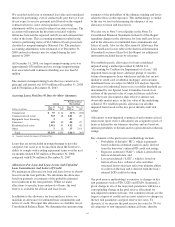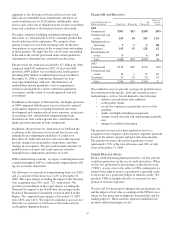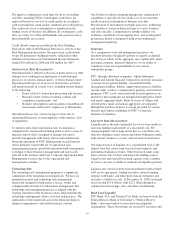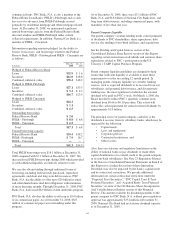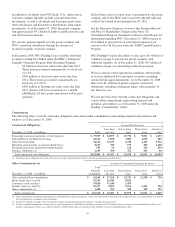PNC Bank 2008 Annual Report Download - page 59
Download and view the complete annual report
Please find page 59 of the 2008 PNC Bank annual report below. You can navigate through the pages in the report by either clicking on the pages listed below, or by using the keyword search tool below to find specific information within the annual report.C
RITICAL
A
CCOUNTING
E
STIMATES
A
ND
J
UDGMENTS
Our consolidated financial statements are prepared by
applying certain accounting policies. Note 1 Accounting
Policies in the Notes To Consolidated Financial Statements in
Item 8 of this Report describes the most significant accounting
policies that we use. Certain of these policies require us to
make estimates and strategic or economic assumptions that
may prove inaccurate or be subject to variations that may
significantly affect our reported results and financial position
for the period or in future periods.
Fair Value Measurements
We must use estimates, assumptions, and judgments when
assets and liabilities are required to be recorded at, or adjusted
to reflect, fair value. This includes the initial measurement at
fair value of the assets acquired and liabilities assumed in
acquisitions qualifying as business combinations under SFAS
141 or SFAS 141(R), “Business Combinations.” The valuation
of both financial and nonfinancial assets and liabilities in these
transactions require numerous assumptions and estimates and
the use of third-party sources including appraisers and
valuation specialists.
Assets and liabilities carried at fair value inherently result in a
higher degree of financial statement volatility. Assets and
liabilities measured at fair value on a recurring basis,
including those elected under SFAS 159, include available for
sale and trading securities, financial derivatives, certain
commercial and residential mortgage loans held for sale,
customer resale agreements, private equity investments, and
residential mortgage servicing rights. Fair values and the
information used to record valuation adjustments for certain
assets and liabilities are based on either quoted market prices
or are provided by other independent third-party sources,
when available. When such third-party information is not
available, we estimate fair value primarily by using cash flow
and other financial modeling techniques. Changes in
underlying factors, assumptions, or estimates in any of these
areas could materially impact our future financial condition
and results of operations.
Effective January 1, 2008, PNC adopted SFAS 157. SFAS 157
defines fair value as the price that would be received to sell a
financial asset or paid to transfer a financial liability in an
orderly transaction between market participants at the
measurement date. SFAS 157 established a three level
hierarchy for disclosure of assets and liabilities recorded at
fair value. The classification of assets and liabilities within the
hierarchy is based on whether the inputs to the valuation
methodology used in the measurement are observable or
unobservable.
The following sections of this Report provide further
information on this type of activity:
• Fair Value Measurements and Fair Value Option
included within this Item 7, and
• Note 8 Fair Value included in Notes to Consolidated
Financial Statements in Item 8 of this Report.
Allowances For Loan And Lease Losses And Unfunded
Loan Commitments And Letters Of Credit
We maintain allowances for loan and lease losses and
unfunded loan commitments and letters of credit at levels that
we believe to be adequate to absorb estimated probable credit
losses inherent in the loan portfolio. We determine the
adequacy of the allowances based on periodic evaluations of
the loan and lease portfolios and other relevant factors.
However, this evaluation is inherently subjective as it requires
material estimates, all of which may be susceptible to
significant change, including, among others:
• Probability of default,
• Loss given default,
• Exposure at date of default,
• Amounts and timing of expected future cash flows on
impaired loans,
• Value of collateral,
• Historical loss exposure, and
• Amounts for changes in economic conditions that
may not be reflected in historical results.
In determining the adequacy of the allowance for loan and
lease losses, we make specific allocations to impaired loans,
allocations to pools of watchlist and non-watchlist loans, and
allocations to consumer and residential mortgage loans. We
also allocate reserves to provide coverage for probable losses
not covered in specific, pool and consumer reserve
methodologies related to qualitative factors. While allocations
are made to specific loans and pools of loans, the total reserve
is available for all credit losses.
Commercial lending is the largest category of credits and is
the most sensitive to changes in assumptions and judgments
underlying the determination of the allowance for loan and
lease losses. We have allocated approximately $2.6 billion, or
67%, of the allowance for loan and lease losses at
December 31, 2008 to the commercial lending category.
Consumer and residential mortgage loan allocations are made
at a total portfolio level based on historical loss experience
adjusted for portfolio activity. Approximately $1.2 billion, or
32%, of the allowance for loan and lease losses at
December 31, 2008 have been allocated to these consumer
lending categories. The remainder of the allowance is
allocated to the other loans category.
55


